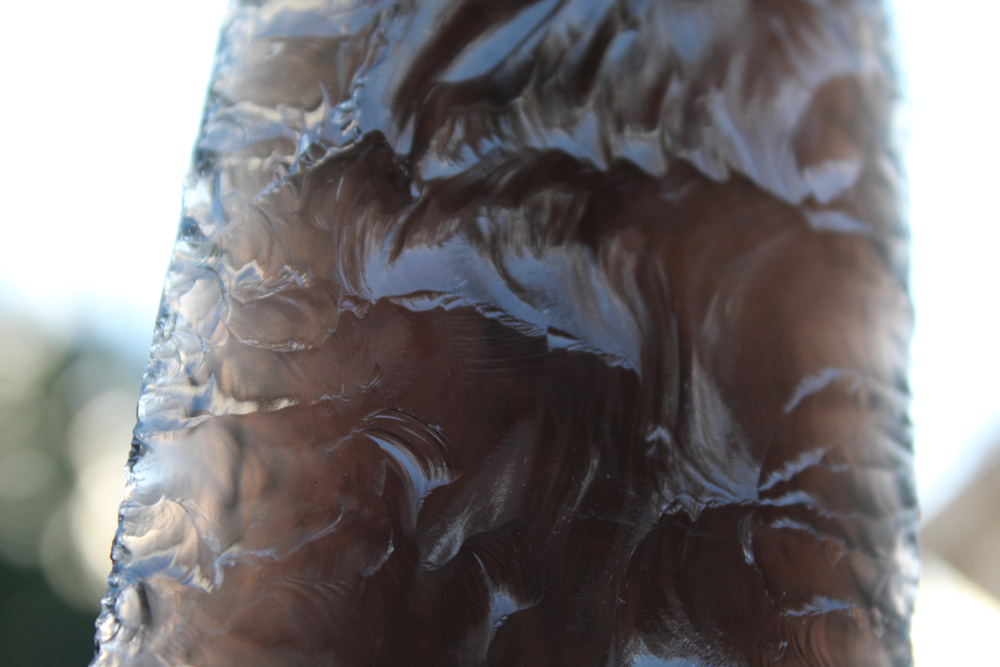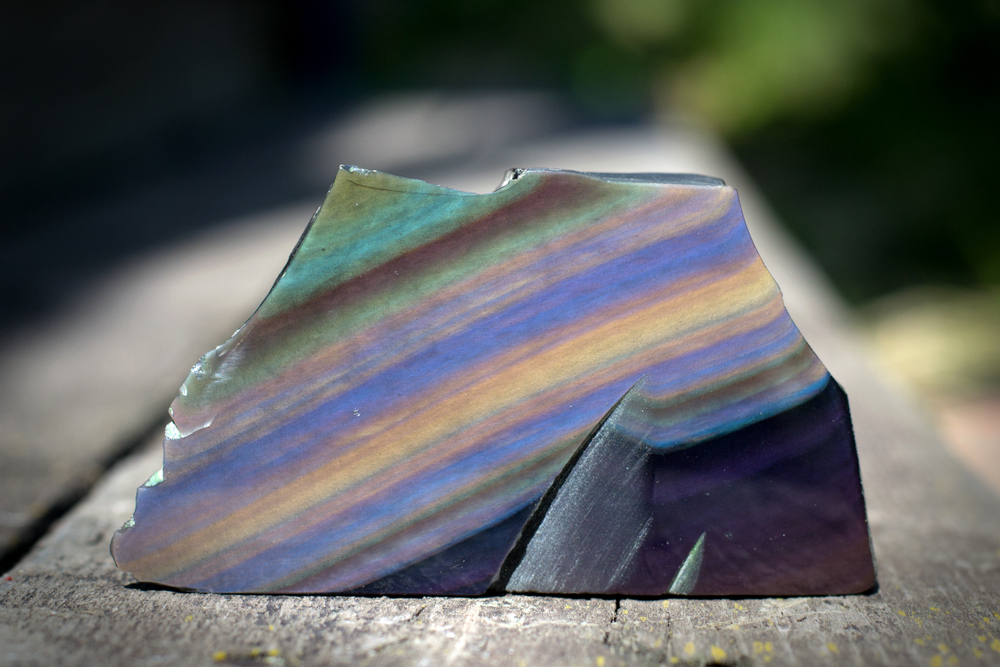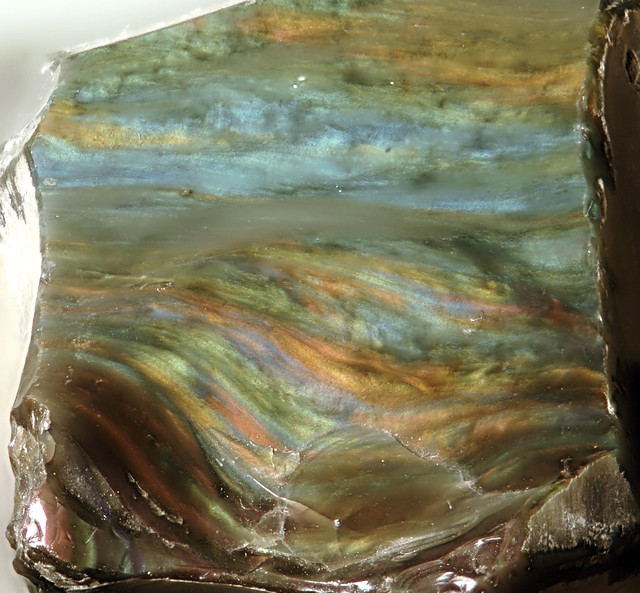Among the most storied types of volcanic glass is rainbow obsidian. It’s not the most common variety of obsidian out there, but the fascinating interplay of colors across its surface has fascinated people for a long, long time. Still, many wonder what causes its seemingly magical optical effect and where they can find their own!
So, let’s take a closer look at rainbow obsidian, what causes its effect, and a couple of public locations where you can dig your own!
What is Rainbow Obsidian?
Obsidian is a volcanic mineraloid glass. It lacks the orderly internal arrangement of atoms required for a compound to actually qualify as a mineral. It generally occurs during extremely fast cooling of silica-rich magma. This silica is almost always associated with iron oxide, which gives obsidian its dark color in most cases.
Historical Uses of Obsidian
Obsidian has a long tradition of use as a tool. To this day, modern flintknappers prize the material even as they also work with modern man-made glasses. Obsidian has a conchoidal fracture, where impacts upon it generally resemble a cone. When a skilled knapper takes advantage of this trait they can leave behind an edge that’s one of the sharpest possible, being close to monoatomic since there’s no crystalline structure that inhibits edge formation.

These edges are quite fragile, which is why copper, then bronze, and finally steel won out as tool materials despite the technology needed to make them. Obsidian still sees some niche use in optical surgery, where specially manufactured obsidian scalpels are considered superior since they leave a cleaner edge.
Obsidian is pretty unstable, at least on a geological time scale. The material is brittle and weathers with exposure before being metamorphosed into other forms of silica. Obsidian is generally less than 20 million years old.
Rainbow obsidian is a specific variety. When held up to the light and turned, rainbows seem to “dance” just under the surface of the rock. In obsidian, you’ll generally see these colored effects referred to as a sheen.
Rainbow obsidian is still prized by knappers, but it’s also found its way into jewelry and just as display. Like all obsidian, where it forms there’s quite a bit of it so it’s not hard to find for purchase. The bulk of the material on the market is from the Mexican state of Jalisco, for reasons I’ll discuss below.
What Creates the Sheen in Rainbow Obsidian?
While sheens in obsidian can often appear to be magical, they’re generated by very real phenomena. Gold and silver sheen, for instance, are actually the effects of minute amounts of water that were trapped during the rapid cooling of the obsidian. These microscopic bubbles then give the appearance of gold or silver as light passes through them at the right angle.
Rainbow obsidian, on the other hand, is colored by inclusions. In this case, the mineral responsible is hedenbergite. Hedenbergite is a relatively rare member of the pyroxene group, associated with iron. It’s rarely found as a pure substance and is most often known in the form of monoclinic crystals.
In rainbow obsidian, this mineral takes the form of nanorods. These are very, very tiny structures. They orient in a particular way in rainbow obsidian, thus creating the optical effect known as thin film interference.
The best example of thin-film interference, perhaps, from our daily life is an oil slick on water. Essentially you’re seeing the reflection of the hedenbergite and the obsidian itself interfere with itself when the light hits properly.
Don’t confuse rainbow obsidian with fire obsidian either. While both are colored by thin-film interference, fire obsidian has inclusions of nanoparticles of magnetite instead of the rods of hedenbergite.
Rainbow obsidian may or may not have a strong sheen depending on how it was cut and the internal composition. While most pieces you’ll find online show strong, bold colors from all angles this hasn’t been the norm in my experience, and others may require more careful angles.

Where Can I Find Rainbow Sheen Obsidian?
For those who want to find some of their own, you’re not out of luck! Particularly if you happen to live in the Pacific Northwest.
There’s a bit of a catch, and it’s the reason the actual marketplace is dominated by the colorful material from Jalisco.
Modoc National Forest
Modoc National Forest is the location of the two mines in the USA known to yield rainbow obsidian on a regular basis. These mines are the Lassen Creek Mine, and the Middle Fork Davis Creek Mine, which are two of the four mines found in the national forest.
You can go to collect up to three times per year, but the permit needs to be purchased prior to heading out. There are limits on the weight and size of what you can take, and it’s limited to only being collected for personal use. The collection is also only permitted outside of winter since the terrain becomes forbidding and the Forest Service folks don’t want to drag collectors back down the mountain.
For that reason, any Davis Creek or Lassen Creek rainbow obsidian you see online is likely either old stock (awesome!) or being sold illegally (not so awesome). This is mainly to deter illegal mining, which would erode this natural resource and the forest it inhabits.
Glass Butte, Oregon
Farther north, in Oregon, we find Glass Buttes. These are mountains made almost entirely of obsidian, in a remote area off of the 20. This area hosts an incredible variety of obsidian, from plan black to mahogany to even limited amounts of rainbow obsidian. It just depends on where you’re digging.
While this is public land, you’ll have to be careful to respect the boundaries of any claims that have been laid in the area. These claims were laid prior to 1969, evading the rockhounding area designation of Glass Buttes. The area around also has newer claims that have been laid, so it’s a matter of doing your due diligence. If you didn’t and get caught, I’d advise leaving instead of arguing.
Jalisco, Mexico
Finally, if we go much, much further south there is the rainbow obsidian of Jalisco. It appears there is a single mine in this location, but it produces large amounts of rainbow obsidian. I’m not too sure about rockhounding regulations in Mexico or access to rainbow obsidian in the area. You’d have to ask a local to be sure.
Some Tips for Working with Rainbow Obsidian
When working with rainbow obsidian there are a few things to keep in mind, especially since most of us are trying to preserve the flash as much as possible.
The first thing you need to do with a new piece of rough is getting it wet and look at it in direct sunlight to find the angle where the banding is most visible. These bands are your guide and they don’t appear from all angles, you’re trying to find the best viewing angle to know how to cut.
Once you have the band’s orientation figured out there are a couple of theories on how to proceed. My personal opinion, for cabs, is that it’s easiest to just cut directly parallel to the bands. Others claim 15° off-parallel is better, and I’ve even heard 12° at times.
Parallel cuts will give you a full-color slab, while cuts made from angles will make the slab directional. There’s plenty to play with if you’re a fan of optical effects, but it’s not the cheapest rough in the world.
This seems like common sense stuff, but I’ll let you in on a secret I only learned after destroying half of a fist-sized chunk of rainbow obsidian chasing colors: you need to reorient the stone in strong lighting between each slab.
Because of the nature of the optical effect, thicker slabs than normal are also a good idea. ⅜” to ½” is usually recommended, as opposed to the ⅛” to ¼” slabs that are common in the rock trade.
You want a high, strong dome to create the strongest colors. When the material gets thinner they weaken, sometimes fading into nothing at all. Trust me, I cut my teeth on agates and I love low-profile cabochons, but it’s not ideal in this case.
If you’re a jeweler, you can somewhat recover from this by using a black backing behind the cabochon but it’s not the same. Just go with the thicker dome.
Like all obsidian, rainbow obsidian is a pain to master when it comes to polishing. I have no serious advice for you there, I’ve generally found cerium oxide paste with a felt wheel on my flex shaft to be the best route, but lapidary machines don’t quite polish the same way.
- Online rock and mineral club for collectors of all levels!
- Find community with like-minded rock and mineral enthusiasts.
- Monthly Giveaways!
- Free Access to Entire Digital Library of Products (annual memberships)




